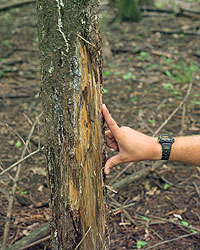Fermilab ecologists take to skies for annual deer count
 |
| An overpopulation of deer can damage the ecosystem. Damage done to a tree by deer is visible in the photo from 1997. |
If you see a helicopter overhead today, go ahead and wave.
Rod Walton, Fermilab's ecologist, and Ryan Campbell, environmental consultant, will take to the skies this morning to survey Fermilab's whitetail deer population.
They'll make several passes over the site, systematically counting the whitetail deer in quadrants of the laboratory as part of Fermilab's annual deer population survey.
A pilot has to fly the helicopter at 300 to 500 feet above the ground for the ecologists to count effectively. If the helicopter is too close to the ground, deer get frightened and scatter, and if it is too high, the deer are difficult to see. They do the survey in the winter when the deer are easier to spot.
"You can't do it unless there is a good snow cover," Walton said. "It has to be a sunny, snowy morning, so they cast a slight shadow."
Walton started the deer-counting program 10 years ago as a method of tracking the population. After each count, Walton reports the number of deer to the U.S. Department of Agriculture, and the organization then removes excess deer.
"Ten years ago, if you walked into Big Woods, there was nothing on the ground. You could see all the way through the woods. It looked like someone had gone through the forest with a lawn mower upside down and had trimmed everything at the same height," Walton said. "We do this for the health of the ecosystem."
When the program began, there were between 600 to 800 deer on site, and 15 to 25 deer-related car accidents on site per year. Today the USDA keeps the herd between 100 to 150 deer, and Fermilab has had one or two deer-related accidents each year.
"Now we have a very consistent and healthy population," Walton said. "We only need to remove 25-50 deer each year."
Each deer is autopsied to assess its condition and look for disease, and the deer meat is donated to local food pantries in Cook, DuPage and Kane counties.
-- Rhianna Wisniewski |